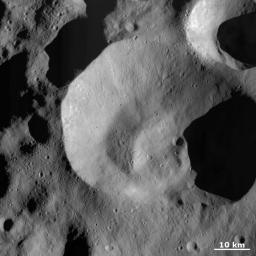This Dawn FC (framing camera) image is dominated by Caparronia impact crater. Caparronia crater is approximately 55 km in diameter and has a mostly fresh, irregularly shaped rim. It also has a curved, linear mound running across most of its base. For all of these reasons Caparronia is a distinctive crater and this is why it was chosen to name the quadrangle in which it is situated. The smooth region around Caparronia crater is most likely fine impact ejecta, which were thrown out from the crater at the time of its formation. Other impact related features are the linear chains of small, less than 1km, secondary craters that occur throughout the image. Some particularly distinctive crater chains are in the bottom part of the image. Secondary crater chains are formed when relatively large debris are ejected from an impact and skip along the surface, much like a stone skipping across a lake. There are also some linear scars running diagonally across the image, which are due to debris scouring across the surface.
This image is centered in Vesta's Caparronia quadrangle and the center latitude and longitude of the image is 52.5°N, 149.2°E. NASA's Dawn spacecraft obtained this image with its framing camera on October 23rd 2011. This image was taken through the camera's clear filter. The distance to the surface of Vesta is 700 km and the image has a resolution of about 70 meters per pixel. This image was acquired during the HAMO (High Altitude Mapping Orbit) phase of the mission.
The Dawn mission to Vesta and Ceres is managed by NASA's Jet Propulsion Laboratory, a division of the California Institute of Technology in Pasadena, for NASA's Science Mission Directorate, Washington D.C. UCLA is responsible for overall Dawn mission science. Dawn's VIR was provided by ASI, the Italian Space Agency and is managed by INAF, Italy's National Institute for Astrophysics, in collaboration with Selex Galileo, where it was built.
More information about Dawn is online at http://www.nasa.gov/dawn and http://dawn.jpl.nasa.gov.

 Planetary Data System
Planetary Data System












